3 Chapter 4: Moving your Classes Outdoors

Hawes C. Spencer, Journalism Instructor, School of Media Arts and Design
“The pandemic made me flip my classroom– and take it outside”
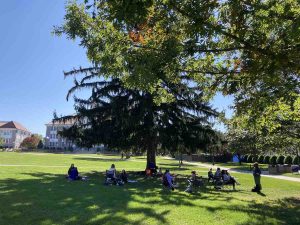
The pandemic forced me to flip my classroom, move outdoors, and give my students a hands-on experience. We’re all better for it, and we’re never going back.
A few months before the pandemic struck, I invited a pair of observers from JMU’s Center for Faculty Innovation into my classroom to debrief the students on what they liked and did not like about my introductory journalism course. I’ll skip what they liked and move to the more salient issue of what they saw as avenues for improvement: more collaborative workshops and more peer-to-peer projects. The way to accomplish this, one facilitator said, was to flip the classroom.
He also led me to the 2015 article “An Examination of the Flipped Classroom Approach on College Student Academic Involvement” in the International Journal of Teaching and Learning in Higher Education. There, I found that today’s students routinely expect a flipped classroom and that such classes produce greater learning. Now I’d been hearing about the so-called “flipped classroom” for years. After all, it’s not terribly different from that time-tested pedagogical format known back in the antiquity of my own college days as a seminar.
Unlike a seminar, however, which was mostly discussions based on readings, today’s flipped classroom leans on technology. In addition to readings, there’s an expectation that the instructor will provide an advance lecture delivered as a video or– as I do it– as a voice-over slideshow, i.e. a “screencast.” The idea is to prepare the material advance electronically so that each student can get acquire the knowledge at their own pace and according to their own schedule. This frees up the classroom time for dynamic exercises. This is where advice from the second classroom facilitator was so crucial.
“Your students are clamoring for more workshops out on the Quad.”
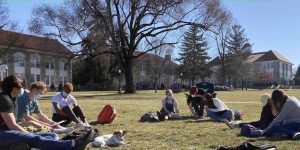
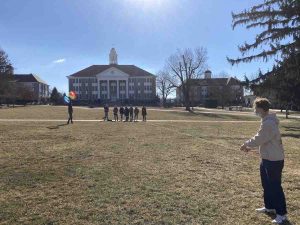
More workshops they want? That’s what they got.
- There was that time that I walked in wearing a bright green alien costume. Not only did they get to know their instructor and each other better, they got to write a headline and a story on deadline.
- Another time we flew a kite on the Quad.
- One time I set up a huge camping tent with mysterious noises emanating from inside.
Each time, they wrote about what they saw, heard, and smelled. Smelled? Yes, one cold winter’s day we used a camp stove to cook pancakes. Each time, I’d leave them alone with portable whiteboards and then come back and issue candid critiques of what they’d written. The idea behind these ungraded exercises was that students get a taste of working under time pressure as a journalist, and they get feedback from their editor, i.e. me. They’d also get something that Joshua Eyler cites as crucial in his popular pedagogy book “How Humans Learn.” They get a chance to fail.
My critiques are based on over two decades as local news editor. And these critiques are not gentle. But they’re candid and quick. And the process often saw the students vying for bragging rights over which group did the best. I think it’s better to have a little bit of a belly-flop in a friendly, conversational setting and thereby clarify expectations. By the time they’re submitting stories for a grade, they have a taste of the process.
Another of our workshops had them pairing off and reciting to one another a traumatic incident from their own history. This so-called “deep listening” exercise helped them hone the skill of paying attention– as it prepared them for interviews.
Another time I had them go out on Quad to track down a stranger, obtain the stranger’s traumatic story, plus the stranger’s name and phone number. At yet another workshop, they had to bring back the story of a stranger’s deceased friend or relative. It’s all part of meeting people and extracting information, essential skills in the journalist’s toolbox.
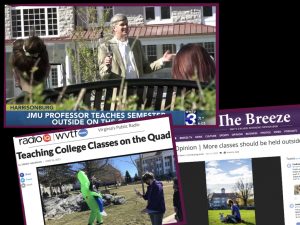
My main thought was this: What could be more safe than being outside, and what could be nicer place than outside in the Quad? (For added distancing when recording interviews with strangers, we use selfie sticks.)
As one of my students told a BreezeTV crew, “I like this class because it gives me more of an opportunity to be with other people.”
Another one of my students revealed that most of her classes were online, so she looks forward to our outdoor learning.
“It kind of gives me an excuse to actually go somewhere and see the sun and be outside,” said the second student.
When I began flipping my classroom, what drove me was the desire to make the precious classroom time matter. My old lecture-based format was adequate, but there needs to be added value from getting together. If it’s just information acquisition, why bother meeting in person? Zoom and Webex are certainly synchronous.
I’ve also thought a lot about the health of JMU and about American colleges in general. Even before the pandemic, the value proposition of the American university was under fire; and making classes going virtual has emboldened critics to suggest that schools are not greatly surpassing what a student might learn on YouTube, Coursera, or Lynda/LinkedIn. Meanwhile, many students and professors were understandably fearful of indoor instruction. Therefore, my strategy allows the instructor to safeguard the health of everyone involved while delivering a meaningfully immersive experience, whether at home or in-person.
That’s because not only am I teaching outdoors, but I’m simultaneously teaching to my remote students. My portable technology kit is not for everyone. It costs nearly $500. But it allows safe and synchronous teaching to help a student who might be falling sick to keep from also falling behind.
Lastly, teaching outside may help JMU answer the clamor from students and parents for normalcy, interactivity, and safety; and it speaks to some of the concepts outlined in Susan Hrach’s recent book, “Minding Bodies: How Physical Space, Sensation, and Movement Affect Learning.”
Some tips:
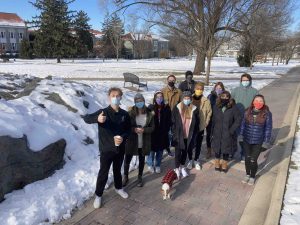
Flexibility – When it’s hot, you teach under a leafy tree and invite students to bring fans. When it’s cold, you teach in the sun or near a wall or wind-blocking evergreen. When it rains, as it will several times each semester, you simply go all-virtual.
Connectivity – You try to find a place where the official university wireless network reaches, but you can also use your phone’s hotspot.
Instruction – You must employ the flipped classroom. Formerly known as the seminar, the flipped classroom pushes the instructor to devise various discussions and workshops that promote community, interactivity, and practice based on the readings and the advance-sent lecture. I happen to use Apple Keynote, over which I provide some narration. But I’m sure that Powerpoint and other delivery systems work equally well.
Gear – In addition to the laptop or tablet computer that serves as your Zoom/Webex focal point, you must obtain four pieces of gear: a tripod with shelf, a rotatable webcam, a speaker, and a parabolic microphone. This gear costs about $500.
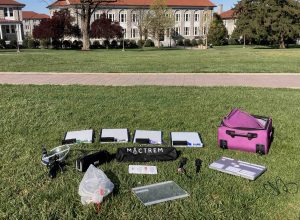
Here’s what’s NOT needed:
– special outdoor seating (students bring their own)
– tents and outdoor structures (just go where you want)
– electronic screens (too hard for all to see)
– any IT-supplied AV equipment (bring your own)
Lastly, during the spring 2021 semester, one of my young adult children was injured (thankfully, not seriously) in a car accident near her home in Colorado. I needed to go out and see her. Back in the olden days I’d have had a choice: Cancel a week’s worth of classes or neglect my child. With remote learning, I was able to teach from Colorado that week, and my two sections of introductory journalism stayed on track.
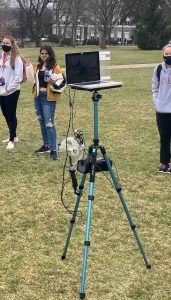
I guess the point that I’m trying to make is that technology is a useful tool, and I’m glad that I could employ Zoom in a pinch. But at the end of the day, I’d much rather be remembered as the guy who taught out on the Quad.
Watch a 4.5 minute video about Teaching Outside: https://www.youtube.com/watch?v=9RfqJafb2rM

